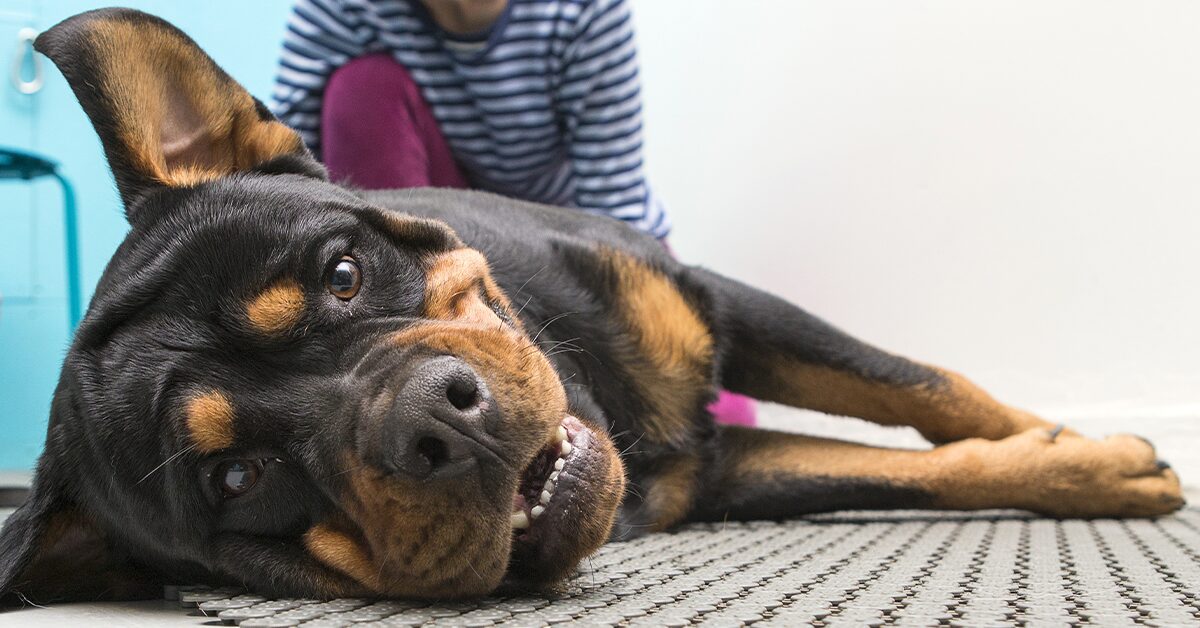It’s hard to see your beloved pup struggling with pain and stiff joints, especially if you’ve tried everything to alleviate it. If you’re at the end of your rope, chiropractic care may be worth looking into.
Animal chiropractic care is gaining popularity as an alternative treatment for dogs suffering from mobility problems. Used in combination with assessment and treatment from your veterinarian, chiropractic care can show significant results for dogs, alleviating pain and stiffness.
If you aren’t sure what dog chiropractors do and how they can help, we’re covering everything you need to know here.
What is dog chiropractic care?
Chiropractic care, aka manipulating the spine to trat disease and pain, became an alternative treatment for animals in the late 1980s. Animal chiropractors have specific training in chiropractic theories and animal anatomy, completing 120 additional hours of practice and rigorous testing to gain certification.
American Veterinary Chiropractic Association (AVCA) is the primary national certification for animal chiropractors in the United States. Their international organization is International Veterinary Chiropractic Association (IVCA). A good dog chiropractor will have an affiliation with these organizations.
How chiropractic care for dogs works
Good spine health largely depends on your dog’s nervous system. Just like humans, he central nervous system controls nearly all functions in your dog’s body, beginning at the base of the brain and ending in the middle of the hips.
The spinal column is comprised of moveable bones, or vertebrae, that protect the spinal cord and nerve pathways. The nerves in the nervous system travel down the spinal column and exit through openings in the column, forming a complex network of communication that influences every living tissue in the body.
In between the vertebrae are gel-like discs that help stabilize the spinal column so your dog can bend, twist, jump and run. Think of them as shock absorbers.
When the spinal column becomes misaligned (subluxations) from injury, degeneration, or disease, the nerves become irritated and painful and can’t communicate as effectively, causing a nervous system malfunction. These discs may bulge or even herniate, causing pain and discomfort.
Veterinarians certified in animal chiropractics manually, or with a tool called an actuator, manipulate the vertebrae, joints, and soft tissues back into alignment, restoring nervous system function and easing or reducing painful symptoms.
Most dogs will respond favorably in a few minutes to a few hours after manipulation. However, it doesn’t always happen in one visit. Many dogs, depending on the severity of their condition, will require multiple chiropractic appointments.
Which dogs can benefit from chiropractic care?
All dogs can benefit from regular chiropractic care, just as humans can. It is safe for your canine companion, with very few side effects. In fact, some dogs may benefit from preventive chriopractic treatments.
For example, dogs predisposed to Intervertebral Disc Disease (IVDD), like the Dachshund, Corgi, or Basset Hound, can benefit from regular assessments before the issues of IVDD arise.
Chiropractic adjustments can help dogs with symptoms of IVDD, but it’s important to have an assessment by your regular veterinarian to ensure there are no herniated discs as those may require surgery. A chiropractic adjustment with no X-ray could cause further damage. The best course of action for dogs with this condition is a referral to an animal chiropractor from your primary veterinarian.
Other dogs who may benefit from chiropractic care include:
- Senior dogs with mobility issues such as arthritis, hip dysplasia, degenerative myelopathy, or urinary and fecal incontinence, to name a few. Since alignment restores the normal nerve pathways of the nervous system, they may enjoy a more comfortable life with regular adjustments.
- Dogs who repeatedly pull on their leashes can cause misalignment and suffer from neck and back pain. Occasional chiropractic adjustments can restore alignment and ease their discomfort.
- Agility, field training, and working dogs can benefit from regular chiropractic care, as keeping their flexibility and mobility at its best can reduce the risk of injury.
- Dogs who have undergone surgery and are working through rehabilitation may also benefit from spinal adjustments.
Signs suggesting chiropractic care for your dog may include:
- A stiff or irregular gait
- Lameness
- Sitting or standing in an abnormal position (the puppy side sit)
- Shorter stride or abnormal gait
- Trouble climbing stairs
- Limping or dragging a leg or both back legs (degenerative myelopathy)
- Hunched back
- Sensitivity to touch or yelping if you pick them up
- Incontinence or lack of bowel control
- Stress or separation anxiety
What to expect at your dog’s chiropractic appointment
A certified veterinary chiropractor should work closely with your veterinarian to prepare a holistic treatment plan. The consultation will include a complete medical history, previous X-rays and surgeries, review of current medications and diagnosis, or reason for referral.
Before chiropractic treatment begins, your dog chiropractor will conduct a thorough musculoskeletal evaluation of your dog’s nervous system. Reflexes, muscle function and control, posture, gait, and flexibility are all parts of a thorough neurological examination.
X-rays or MRIs may be necessary before they can administer treatment.
After your dog’s first treatment, they may sleep the rest of the day. Spinal adjustments can be uncomfortable, and your dog may experience some soreness for the first day or two. After 24-48 hours, there should be a noticeable improvement.
When the nerve pathways align, your dog’s muscles, joints, and tendons release toxins that can affect your dog’s stools. You may notice some diarrhea or loose stool following the adjustments. Don’t worry, your dog will return to regular bowel movements quickly. If not, you should reach out to your veterinarian for advice.
Most of the side effects are just soreness and loose stools. However, you should always consult with your veterinarian before a chiropractic appointment. If there are fractures or significant injuries present, an adjustment could cause additional damage or worsen the symptoms,
Can I combine alternative therapies and regular veterinary care for my dog?
Yes! Alternative therapies should work in tandem with routine vet visits, giving your dog the best possible treatment options.
Alternative medicine practices like massage therapy, homeopathy, acupuncture, hydrotherapy, and chiropractics are not exclusive treatment methods but part of a larger holistic care plan for your pooch. Working with your regular veterinarian can help ensure your dog has a better chance at long-term relief.
If your dog is not getting around like they used to or you have a working or agility dog that could benefit from regular chiropractic care, perhaps a referral to a certified animal chiropractor can help improve your dog’s quality of life.
After all, who doesn’t want to see their pup running, playing, and jumping for joy for years to come?




